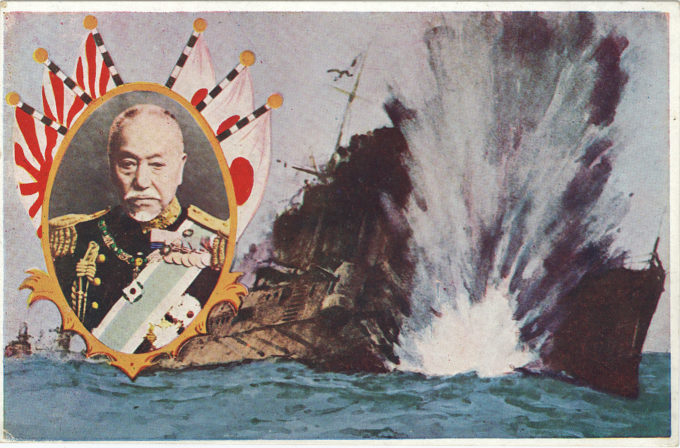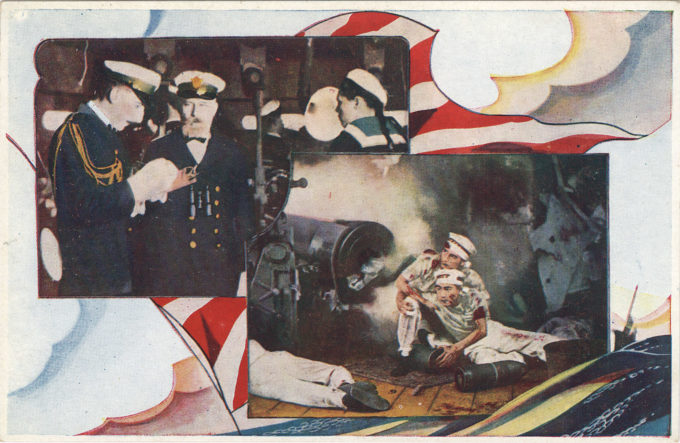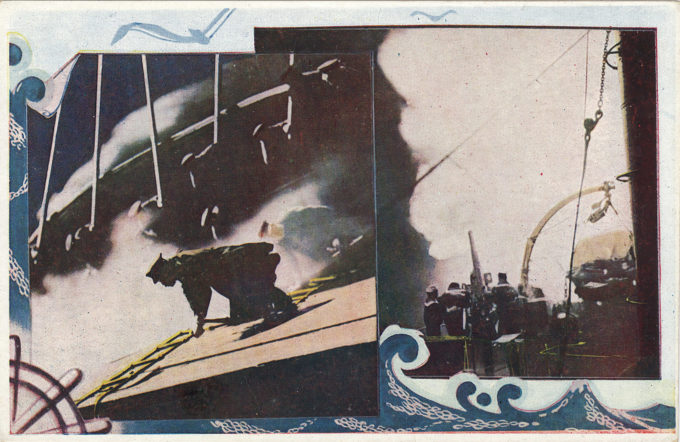
“Gekimetsu” (“Annihilation”) motion picture advertising postcard, 1930. Inset image: Commander-in-Chief of the Combined Fleet, Admiral Togo, as portrayed by famed historical film actor Yamamoto Kaichi. Togo won a decisive naval victory at Tsushima Straits over the Russian Baltic Fleet being sent to relieve the beleaguered Russian Pacific Fleet at Port Arthur. The battle was a humiliating loss for Russia, which lost all its battleships and most of its cruisers and destroyers and which effectively ended the Russo-Japanese War in Japan’s favor. Gekimetsu was a motion picture recreation of the Battle of Tsushima produced in 1930 by Nikkatsu Studios, scripted by the Imperial Japanese Navy’s official historian, Admiral Ogasawara Naganari, and directed by Ogasawara’s son, Meiho.
See also:
Battle of Tsushima Straits propaganda postcard, Russo-Japanese War, 1905.
“This is the Japanese greatest admiral …”, Admiral Togo, 1906.
“Tokyo Matsuri” advertising postcard, 1933.
“In 1930, Nikkatsu Studios released a movie on the Battle of Tsushima in the Russo-Japanese War. Titled Gekimetsu (撃滅), it was written by Viscount Ogasawara Naganari.
“Viscount Ogasawara (1867–1958) had been an Admiral and naval strategist in the Imperial Japanese Navy during the Meiji and Taishō periods in Japan. As an ensign, Ogasawara served in combat during the First Sino-Japanese War (1894-95) before his transfer to the Navy General Staff Records Department where he was assigned to compile an official record of naval operations during the war (which was published in 1903). Ogasawara continued to serve on the General Staff as a naval intelligence officer through the Russo-Japanese War (1904-05) and World War I, rising to the rank of vice admiral by 1918.
“Ogasawara was an expert on codes and ciphers, but by the time he had reached flag rank, he was best known as a public relations expert for the navy, with his colorful writings on naval history earning him the nickname of the ‘literary admiral’. He was also a close confidant of Fleet Admiral Tōgō Heihachirō and an early proponent of the naval strategies of Alfred Thayer Mahan. Ogasawara would later become an instructor at the Naval War College, where he continued to stress the importance of sea power.
“Viscount Ogasawara’s eldest son, Meiho Ogasawara, became a movie director, and later a movie producer. His younger son, Shojiro, became an actor. In 1930, Nikkatsu Studios released a movie on the Battle of Tsushima in the Russo-Japanese War. Titled Gekimetsu, it was written by Viscount Ogasawara, directed by one son (Meiho) with his other son (Shojiro) in its cast.”
– Wikipedia
- “Gekimetsu” (“Annihilation”) motion picture advertising postcard, 1930.
- “Gekimetsu” (“Annihilation”) motion picture advertising postcard, 1930.
“There have been few large-scale engagements [of this magnitude]. Between the days of sail and the World War, Tsushima was without a rival in magnitude. It was the major battle of fleets between [the battles of] Trafalgar and Jutland. Every move by every ship has been scrutinized under the critical microscopes of the naval war colleges of the world.
“[But] Tsushima was not an action of simple development and position. There were diverse and widely separated synchronous operations more difficult to contemplate in their entirety than a circus with three rings and various side-shows.
“… The Japanese Empire had two great assets out there on the high seas. One was the superior speed built into her ships during the days of peace, a sine qua non for extrication from that afternoon’s crisis. The other was the lump of grey matter beneath the cap of the Commander-in-Chief … [Togo] devised the major tactics and he indoctrinated his flag officers with his plans, but when the clash came he could not remain aloof like a general on some lofty eminence remote from the enemy’s fire, supervising slow operations on a wide front. Rather was he like a cavalry leader galloping at the head of his premier troop, against the enemy’s centre, leaving the flank charges to trusted subordinates guided by instantaneous decisions combining command with precept.
“… It was some time before Togo was able to check off from his list the few ships which had not been sunk or captured but by the night of the twenty-eighth he knew that he had scoured Japanese waters of the invaders and had achieved one of the most crushing naval victories in all history.
“The deaths were 4830 Russians and 117 Japanese, and the total casualties over 10,000 and under 1000, respectively. Togo’s losses in ships were three torpedo – boats against virtually the entire Russian armada.
“Japan was thrown into a frenzy of combined relief and unrestrained ecstasy. Not only was the threatened invasion of home waters repulsed, the enemy shattered and the war won , but there surged from the Soya Strait to Kagoshima Bay the conviction that the Imperial Navy had restored to the Mikado the domination of his seaways lost in the early era of steam.
“… Togo was the hero – not of the hour but of the centuries.”
– Togo and the Rise of Japanese Seapower, by Edwin A. Falk, 1936



